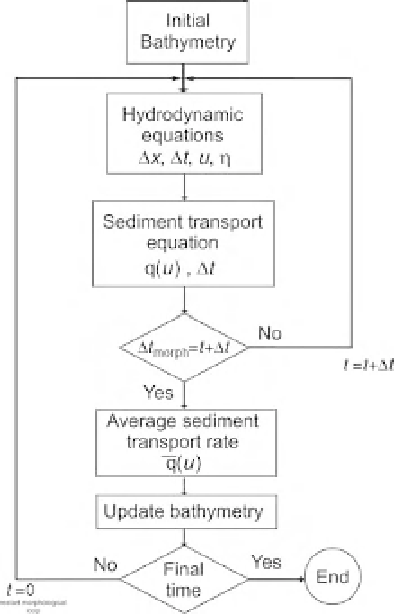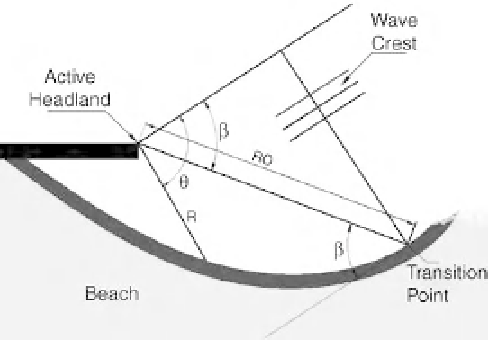Environmental Engineering Reference
In-Depth Information
bathymetry is often considered fixed for the hy-
drodynamic step until a 'significant' change oc-
curs. At this point the bathymetry is updated and
then the hydrodynamics runs for the updated
bathymetry. There are many uncertainties in the
sediment transport formulae, as well as cumula-
tive errors in the iterative scheme. These models
can be prone to instability due to feedback be-
tween hydrodynamic and bathymetric changes.
This is usually solved by controlling the bed steep-
ness through an 'avalanching' step to prevent
unrealistically steep slopes developing in the pre-
dictions. An example of the structure of a dynamic
process model is shown in Figure 16.3.
Fig. 16.2
An example of a headland bay and the corre-
sponding equilibrium shape.
b
is the angle between the
radius to the transition point and the incoming wave
crests;
u
is the reference angle, which varies from
b
upwards to the maximum required to describe the shape
of the bay; R is the length of the radius from the headland
to the beach line in the bay; R
0
is the baseline radius - the
length between the headland and the transition point;
the transition point is the location on the beach where
the tangent to the beach is parallel to the incoming wave
crests.
Hybrid models
This type of model often employs a simplifica-
tion of the physical processes into a few evolutio-
nary equations (e.g. Stive and De Vriend 1995;
Medina (2001), who discuss some of the uncertain-
ties surrounding this technique.
Due to their generic nature these models have
wide applicability; they provide a simple way of
predicting the stable bay shape and the typical
profile. Fluctuations from these forms arise from
the fact that beaches are rarely in strict
equilibrium.
Deterministic process models
These are computational models that solve the
equations of motion expressing conservation of
mass and momentum for water, and mass conser-
vation for sediment. They include detailed de-
scriptions of the sediment transport process,
including suspension, transport and settling. The
models are iterative, requiring sequential solution
of the hydrodynamics, sediment transport (q)
and bathymetric updating. Time steps for hydro-
dynamics (
D
t) are usually much shorter than
for the bathymetric updating (
D
t
morph
). Hence,
Fig. 16.3
Example structure of a detailed process model
of coastal morphology.


